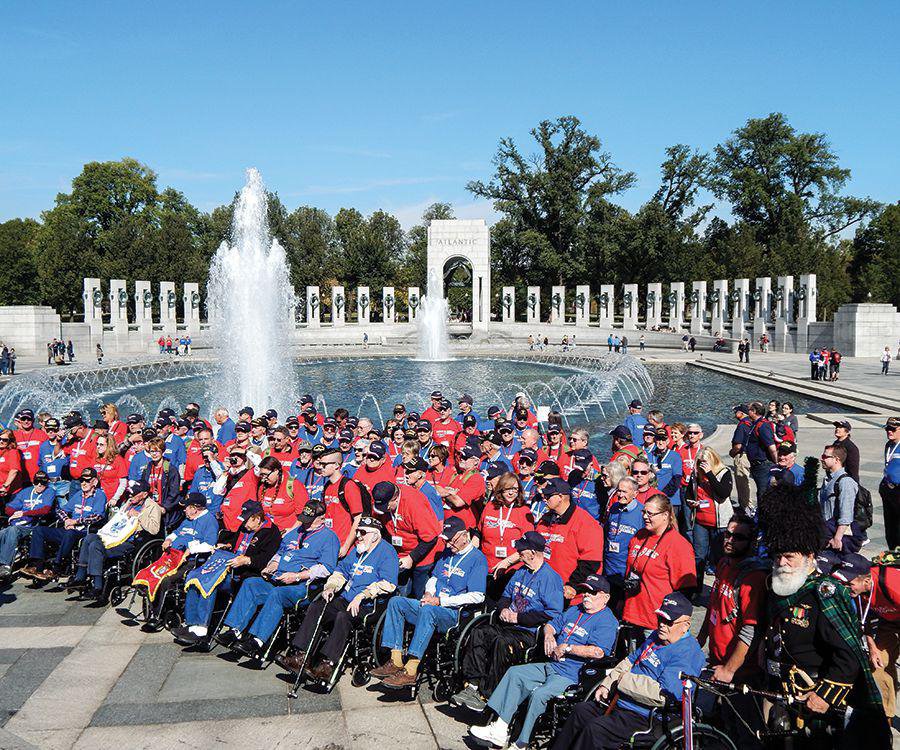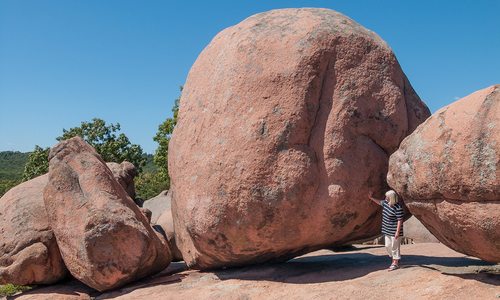
Lifestyle
Honor Flight of the Ozarks
Decades after local veterans returned home from war, Honor Flight of the Ozarks gives them a VIP experience that salutes them as champions of American history.
By Jennifer Adamson
Dec 2015

Don Akers has lived most of his life feeling deeply connected to his experiences as a Korean War veteran. Though he didn’t serve on the front lines, he played an important role in ensuring American soldiers’ safety. In the early 1950s, the Springfield native was stationed stateside at Fort Belvoir in Virginia as an Army engineering instructor, teaching engineering officers how to design and build timber trestle bridges over which the infantry crossed.
Now 88 and confined to a wheelchair, Akers had given up on being able to see the Korean War Memorial until he was invited to join other veterans on a trip to Washington, D.C. on October 20 with Honor Flight of the Ozarks.
“Because of what they did, we still have our freedoms,” says Walt Cameron, director of the organization, a nonprofit that funds flights to our nation’s capitol for veterans to see the memorials that glorify their military accomplishments.
With rumors circulating that local flights are not being offered due to lost sponsorship, Cameron is making it his mission to keep the organization operational and ensure Akers and other 417-land veterans have a chance to be recognized for their service, reconnect with their memories and reconcile their pasts.
POWERFUL MEMORIES
For these sometimes-forgotten veterans and their loved ones, traveling together was a rare opportunity to be around others who have also experienced the patriotism, camaraderie and sacrifice that binds generations of war.
The excursion begins in Springfield, where 75 veterans and their guardians board a chartered jet to D.C. They travel by bus to the World War II, Korean War, Vietnam War and Marine Corps memorials, and also visit Arlington National Cemetery for the Changing of the Guard Ceremony at the Tomb of the Unknown Soldier. Throughout the day, veterans are personally thanked. “Many of these veterans have never received recognition and don’t feel like they deserve it,” Cameron says. “They feel like their mission isn’t over.”
The pilgrimage was especially moving for Jerry Snyder, whose military career came full circle during this trip, which coincided with the 49th anniversary of the day his Army battalion touched down in Vietnam. Overcome by sadness and reluctant to walk the path next to the Vietnam War Memorial alone, his daughter, Stephanie McKinney, led him alongside the black stone wall where names of his fallen comrades are etched.
After a few yards, Snyder dug deep for the strength to stand on his own, let go of McKinney and rubbed his hand across the wall. A passerby thanked him for his service, but he didn’t notice. “It was just like he was stone, too,” McKinney says.

World War II Navy veteran O.K. Armstrong reads a thank-you letter with his guardian, Greg Horton.
A MILESTONE
Since the national Honor Flight Network was established in 2005, 132 flight groups from coast to coast have joined the cause, giving older veterans a chance to see the memorials they’ve waited six or more decades to face. From the Springfield–Branson National Airport, 1,575 veterans have participated, but such a time-sensitive issue as age makes Cameron’s push to get them to D.C. urgent.
For the first time in Honor Flight of the Ozarks’ history, three female veterans, including 91-year-old Rometa Murphy, made roll call on the October flight, and a stop was made at the Women in Military Service for America Memorial.
Murphy, a Navy supply clerk during World War II, was present for the memorial’s dedication in 1997, but hadn’t been back since. This time, she received a special surprise when a memorial representative did a database search and found her photograph from 1944. She’s wearing her dress uniform and the same sisterly smile she’d been sharing with the other female vets on the trip.
“I really didn’t know they had anything like that,” Murphy says. “I feel special to think that I could represent other women, and other women can look up to me. It’s a feeling of unity.”
TIME TO CELEBRATE
At the end of the day, before boarding their return flight home, one last unexpected treat awaits veterans. Tired faces brighten as manila envelopes are pulled from behind the airport ticket counter, a sure sign that mail has arrived. Each envelope is filled with handwritten thank-you notes from across the Ozarks.
One young boy calls Bob Dawes of Urbana an American superhero. “I love these kids,” was all the Vietnam vet could say after clenching his jaw to choke back tears.
Once back in Springfield, similar sentiments are seen waving like the American flag, giving these weary soldiers the proper homecoming they are due.
My grandpa, my hero.
I’m especially proud to be your wife today.
God bless our veterans.
The Missouri State University jazz band plays patriotic songs, commemorative roses are handed out and even strangers embrace the men and women to whom they feel indebted—all of this perfectly capping a day filled with appreciation and enhancing the legacy of American heroes.
POWERFUL RECOLLECTIONS
While waiting for his bus, Clint Masterson of Nixa stared out the airport window, anticipating the day ahead. He sat beneath a baseball cap decorated with medals he earned for serving in the Korean War, among them two Purple Hearts and a Silver Star, awarded for his gallantry in running across enemy fire to reach a machine gun he then used to help stop counterattacks during the Battle of Heartbreak Ridge in 1951.
“Back then, you grew up with the understanding that if your country called you, you went,” he says. “You hoped you’d come back but knew it was a possibility you wouldn’t. I watched a bunch of kids get killed and wondered why it was them who died. This is something that hits pretty close to the heart.”
The pilgrimage was especially moving for Jerry Snyder of Houston, whose military career came full circle during this trip, which coincided with the 49th anniversary of the day his Army battalion touched down in Vietnam. Overcome by sadness and reluctant to make the walk alone, Snyder’s daughter, Stephanie McKinney, led him alongside the black stone wall where names of his fallen comrades are etched.
After a few yards, Snyder dug deep for the strength to stand on his own, let go of McKinney and rubbed his hand across the wall. A passerby thanked him for his service, but he didn’t notice.
“It was just like he was stone, too,” McKinney says.












